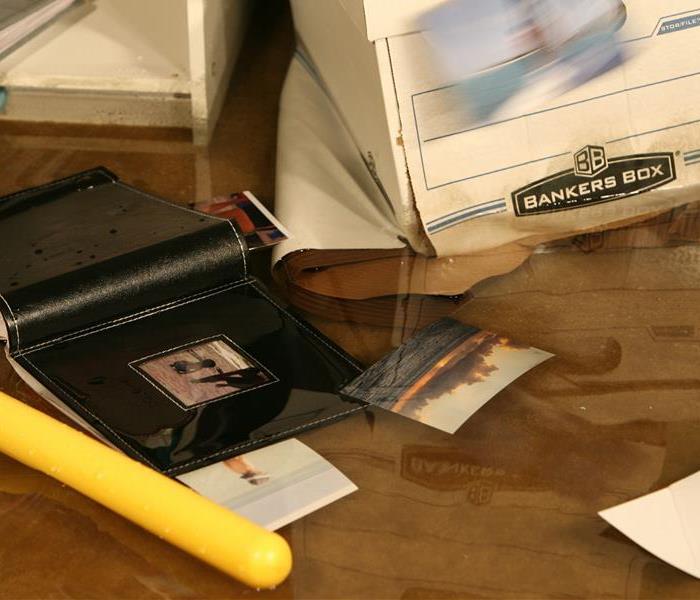Flood Cleanup: Avoiding Indoor Air Quality Problems
1/20/2016 (Permalink)
During a flood cleanup, the indoor air quality in your home or office may appear to be the least of your problems. However, failure to remove contaminated materials and to reduce moisture and humidity can present serious long- term health risks. Standing water and wet materials are a breeding ground for microorganisms, such as viruses, bacteria, and mold. They can cause disease, trigger allergic reactions, and continue to damage materials long after the flood.
Avoid Problems from Microbial Growth
Remove Standing Water
Standing water is a breeding ground for microorganisms, which can become airborne and be inhaled. Where floodwater contains sewage or decaying animal carcasses, infectious disease is of concern. Even when flooding is due to rainwater, the growth of microorganisms can cause allergic reactions in sensitive individuals. For these health reasons, and to lessen structural damage, all standing water should be removed as quickly as possible.
Dry Out Your Home
Excess moisture in the home is an indoor air quality concern for three reasons:
• Microorganisms brought into the home during flooding may present a health hazard. These organisms can penetrate deep into soaked, porous materials and later be released into air or water. Coming in contact with air or water that contains these organisms can make you sick.
• High humidity and moist materials provide ideal environments for the excessive growth of microorganisms that are always present in the home. This may result in additional health concerns such as allergic reactions.
• Long-term increases in humidity in the home can also foster the growth of dust mites. Dust mites are a major cause of allergic reactions and asthma.
Remove Wet Materials
It can be difficult to throw away items in a home, particularly those with sentimental value. However, keeping certain items that were soaked by water may be unhealthy. Some materials tend to absorb and keep water more than others. In general, materials that are wet and cannot be thoroughly cleaned and dried within 24-48 hours should be discarded, as they can remain a source of microbial growth.
Avoid Problems from the Use of Cleaners and Disinfectants
The cleanup process involves thorough washing and disinfecting of the walls, floors, closets, shelves, and contents of the house. In most cases, common household cleaning products and disinfectants are used for this task. FEMA also suggests the use of disinfectants and sanitizers on the ductwork for the heating and air conditioning system, if it has been flooded.
Disinfectants and sanitizers contain toxic substances. The ability of chemicals in other household products used for cleaning to cause health effects varies greatly, from those with no known health effect to those that are highly toxic. Read and follow label instructions carefully, and provide fresh air by opening windows and doors. If it is safe for you to use electricity and the home is dry, use fans both during and after the use of disinfecting, cleaning, and sanitizing products.
Be careful about mixing household cleaners and disinfectants together. Check labels for cautions on this. Mixing certain types of products can produce toxic fumes and result in injury and even death.
Avoid Problems from Airborne Asbestos and Lead Dust
Elevated concentrations of airborne asbestos can occur if asbestos-containing materials present in the home are disturbed. Airborne asbestos can cause lung cancer and mesothelioma, a cancer of the chest and abdominal linings.
Lead is a highly toxic metal which produces a range of adverse health effects, particularly in young children. Disturbance or removal of materials containing lead-based paint may result in elevated concentration of lead dust in the air.
(Source: http://www.epa.gov/sites/production/files/2015-09/documents/floods.pdf)
Have a professional inspect your home or business
Why Choose SERVPRO of Franklin County?
24-Hour Emergency Service
Faster to Any Size Disaster
Highly Trained Mold Remediation Technicians
Specialized Mold Remediation Equipment
A Trusted Leader in the Restoration Industry
Locally Owned and Operated
Any home or commercial property can quickly become infested with mold if a source of water is present. Mold can spread throughout a property in as little as 48 hours. Since mold can produce allergens and irritants, you should call us to inspect your Union home if you suspect you have a mold problem. If mold is found, we have the training, equipment, and expertise to remediate your mold infestation.
Learn more about mold and what to do until help arrives by reviewing these mold damage tips.
We’re Faster to Any Size Disaster
A minor mold problem can quickly become a major infestation if left untreated. We can start the remediation process immediately after you contact us. A faster response lessens the mold damage, limits additional damage, and reduces the remediation cost. Learn More
We’re Highly Trained Mold Remediation Specialists
As water and mold damage specialists, we have the experience, the expertise, and the advanced training that enables us to get your property restored quickly and thoroughly.
We Use Advanced Mold Remediation Techniques and Equipment
Our advanced equipment helps to detect and stop the source of water feeding the mold. We then isolate the affected area using a negative air pressure chamber. Learn More
Locally Owned Company with National Resources
We live and work in this community too; we might even be neighbors. As a locally owned and operated business, SERVPRO of Franklin County is close by and ready to help with your mold-damaged property. We are proud to be an active member of the Franklin County, MO community and want to pitch in and help make our community the best it can be.
When a major storm or event occurs, we can call upon our national network of 1,650 SERVPRO Franchises and special Disaster Recovery Teams if we need additional resources or personnel.



 24/7 Emergency Service
24/7 Emergency Service
